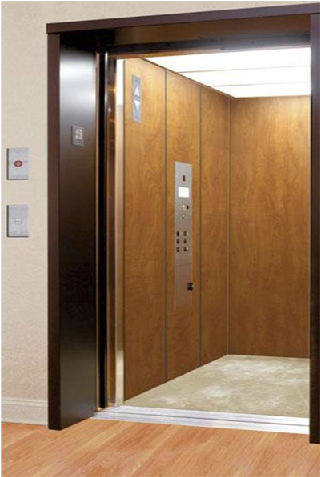Passenger Elevator
Specifications :-
- Best for hotels, malls, Commercial Buildings and Personnel
- Min Capacity 4 person and Max 24 persons
- Carry up to lots of no of floors
- Cabin design as per customer requirement
- Automatic Doors with center Opening & Side opening both types
- Touch screen type LOP or COP facility

FREQUENTLY ASKED QUESTION
A passenger elevator is a type of vertical transportation system designed to transport people between different levels or floors in a building. It consists of a car or cab that moves up and down inside a vertical shaft or hoistway, and is powered by an electric motor. The car is supported by cables or hydraulic systems that are attached to a counterweight, allowing it to move smoothly and safely between floors.
Passenger elevators are found in many types of buildings, from high-rise commercial and residential towers to hospitals, hotels, airports, and shopping malls. They are typically designed to accommodate a certain number of people and have various safety features such as emergency brakes, door sensors, and backup power systems in case of power failure.
Modern passenger elevators come with a range of advanced features such as touchless controls, smart destination dispatch systems, and energy-saving features that use regenerative drives to convert energy into electricity. They are an essential part of modern infrastructure, enabling people to move quickly and efficiently between floors in tall buildings.
There are several different types of elevators, but the three most common types of elevators are:
Hydraulic Elevators: These elevators use a hydraulic piston to move the elevator car up and down. The hydraulic piston is powered by an electric motor and is located at the base of the elevator shaft. Hydraulic elevators are often used in low to mid-rise buildings and have a maximum travel distance of about six stories.
Traction Elevators: These elevators use steel ropes or belts attached to a counterweight and motor to move the elevator car up and down. Traction elevators are typically used in mid to high-rise buildings and can travel long distances.
Machine Room-Less (MRL) Elevators: These elevators are designed to be more space-efficient than traditional elevators, as they eliminate the need for a separate machine room. Instead, the motor and control equipment are located in the hoistway or at the top of the elevator shaft. MRL elevators can be either hydraulic or traction elevators and are commonly used in buildings with limited space or where space for a machine room is not available.
Other types of elevators include geared and gearless elevators, pneumatic elevators, and double-deck elevators. The type of elevator that is best suited for a particular building depends on factors such as building height, travel distance, speed, and available space.
A passenger elevator consists of several key components that work together to transport people between floors. Here is a basic overview of how a passenger elevator works:
The car or cab: This is the compartment in which passengers stand or sit. It is attached to cables or a hydraulic piston and moves up and down inside the vertical shaft or hoistway.
The hoistway: This is the vertical shaft that the elevator travels within. It is lined with guide rails that keep the car moving in a straight line.
The motor: This is the electric motor that powers the elevator. It is located in the machine room, which can be either located at the top of the shaft or in a separate room adjacent to the shaft.
The control system: This is the computerized system that controls the elevator’s movements. It consists of buttons or touchscreens in the car and the elevator lobby that passengers use to select their desired floor. The system then calculates the best route for the elevator to take based on the number of passengers and the desired floors.
The safety system: Elevators are designed with several safety features to protect passengers in case of emergencies. These can include door sensors that prevent the doors from closing if something is blocking them, emergency brakes that stop the elevator in case of power failure, and backup power systems that keep the elevator running during power outages.
When a passenger enters the elevator and selects their desired floor, the control system determines the best route for the elevator to take. The motor then powers the elevator’s movement, while the safety system ensures that the ride is smooth and secure. Once the elevator reaches its destination floor, the doors open, and the passengers exit.
There are several types of elevators available, but the two main types of elevators are:
Hydraulic Elevators: These elevators use a hydraulic system to move the car up and down. The elevator car is supported by a piston at the bottom of the shaft that is filled with hydraulic fluid. When the fluid is pressurized, it pushes the piston and lifts the car. To lower the car, the fluid is released from the piston, causing the car to descend. Hydraulic elevators are typically used in low to mid-rise buildings and have a maximum travel distance of about six stories.
Traction Elevators: These elevators use a motor to move the car up and down. The car is supported by steel ropes or belts that are attached to a motor-driven pulley or sheave. When the motor turns, the pulley rotates, causing the ropes or belts to move and the car to move up or down. Traction elevators are typically used in mid to high-rise buildings and can travel long distances.
